Features of sexual development in children Puberty –


Features of sexual development in children Puberty – Normal and Abnormal Gholam Dastagir Barakzay 46 english group

Puberty Disorders of puberty constitute one of most common referrals to paediatric endocrine clinics Careful history and examination paramount Ensure sensitivity at all times Chaperone during pubertal examination

Puberty Physiological transition from childhood to reproductive maturity Associated with: Growth spurt Appearance of both primary and secondary sexual characteristics in children Occurs between 8 and 14yrs in girls Occurs between 9 and 14yrs in boys

Puberty Important to understand Range of normal Population differences

Normal Puberty: Endocrine control Onset of puberty signalled by the secretion of pulses of Gonadotrophin Releasing Hormone (GnRH) Prior to puberty: hormonal feedback / central neural suppression of GnRH release suppress onset of puberty Hypothalamo-pituitary-gonadal axis starts working in foetus. After birth, sex hormones and gonadotrophins (FSH, LH) found in adult levels Levels reduce in months after birth; pulsatile GnRH reduces in childhood and increases in frequency and amplitude before puberty For 2 yrs before puberty, rise in adrenal androgens early pubic hair and spots


Physiology of Puberty Activation of the hypothalamic – pituitary – gonadal axis Induces and enhances progressive ovarian and testicular sex hormone secretion Responsible for the profound biological, morphological and psychological changes which adolescents experience

Influencing Factors Genetics: 50-80% of variation in pubertal timing Environmental factors e.g. nutritional status Leptin → regulates appetite and metabolism through hypothalmus. Permissive role in regulation of timing of puberty Adrenarche: development of pubic and axillary hair, body odour and acne

Adrenal Steroids DHEA, DHEA-S, Androstenedione Begins before rise in gonadotrophin secretion Responsible for appearance of axillary hair ad in part for appearance of pubic hair (adrenarche)


Physical Changes 5 stages from childhood to full maturity Marshall and Tanner (P1 – P5) Reflect progression in changes of the external genitalia and of sexual hair Secondary sexual characteristics Mean age 10.5yrs in girls Mean age 11.5 – 12yrs in boys

Puberty: Girls Breast enlargement usually first sign. Thelarche Often unilateral Menarche usually 2-3 yrs after breast development Growth spurt peaks before menarche Pubic and axillary hair growth: sign of adrenal androgen secretion Starts at similar stage of apocrine gland sweat production and associated with adult body odour

Examination: Girls Examine in supine position. Helps differentiate between true breast enlargement vs adiposity Genital exam: pubic hair, changes in vaginal mucosa. Cliteromegaly suggests androgen excess and virilisation Mild acne normal in early puberty but rapid onset and progression may suggest androgen excess Vaginal exam only if sexually active NEVER rectal exam

Pubertal Stages (Tanner) Female P1 Prepubertal P2 Early development of subareolar breast bud +/- small amounts of pubic and axillary hair P3 Increase in size of palpable breast tissue and areolae, increased dark curled pubic/axillary hair P4 Breast tissue and areolae protrude above breast level. Adult pubic hair but no spread to medial thighs. P5 Mature adult breast. Pubic hair extends to upper thigh

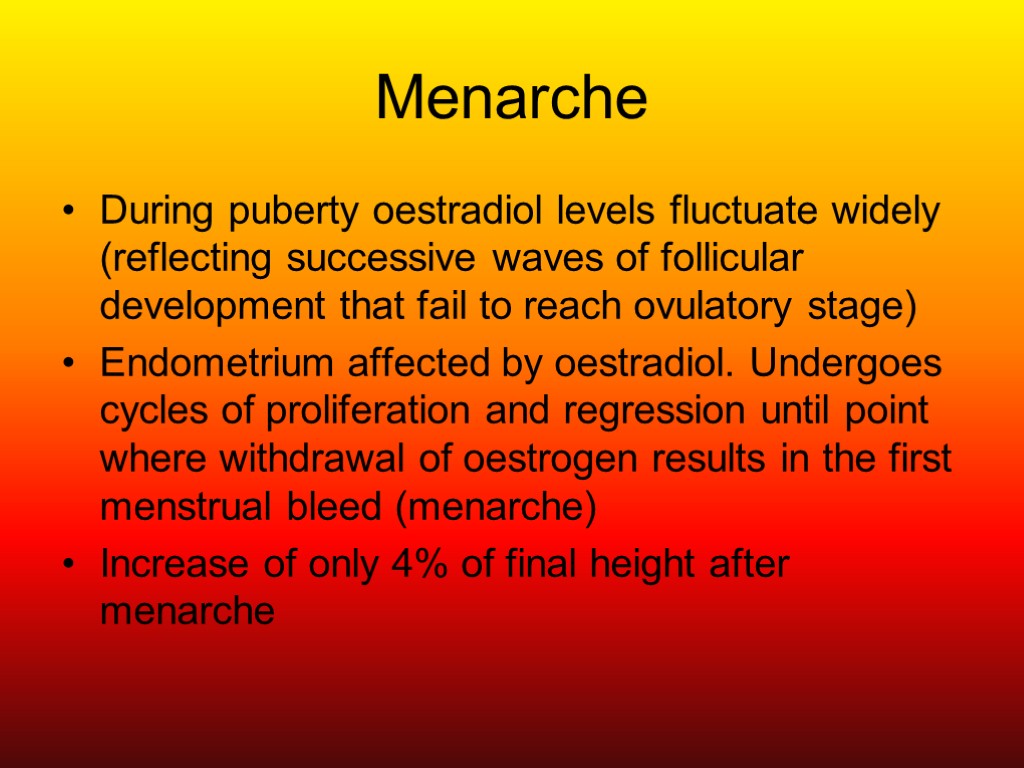
Menarche During puberty oestradiol levels fluctuate widely (reflecting successive waves of follicular development that fail to reach ovulatory stage) Endometrium affected by oestradiol. Undergoes cycles of proliferation and regression until point where withdrawal of oestrogen results in the first menstrual bleed (menarche) Increase of only 4% of final height after menarche

Ovarian development Rising levels of plasma gonadotrophins Stimulate ovary to produce increasing amounts of oestradiol Oestradiol ► secondary sex characteristics Breast growth and development Reproductive organ growth and development Fat redistribution (hips,breasts) Bone Maturation

Ovarian development Prepuberty volume – 0.3 – 0.9cm3 > 1.0cm3 indicates puberty has begun During puberty – rapid increase in size Mean post pubertal volume 4cm3

Ovulation First ovulation occurs 6 – 9 mths after menarche Plasma progesterone remains at low levels even if secondary sexual characteristics have appeared Rising progesterone after usually ► ovulation Plasma testosterone rise during puberty (not as much as in male)
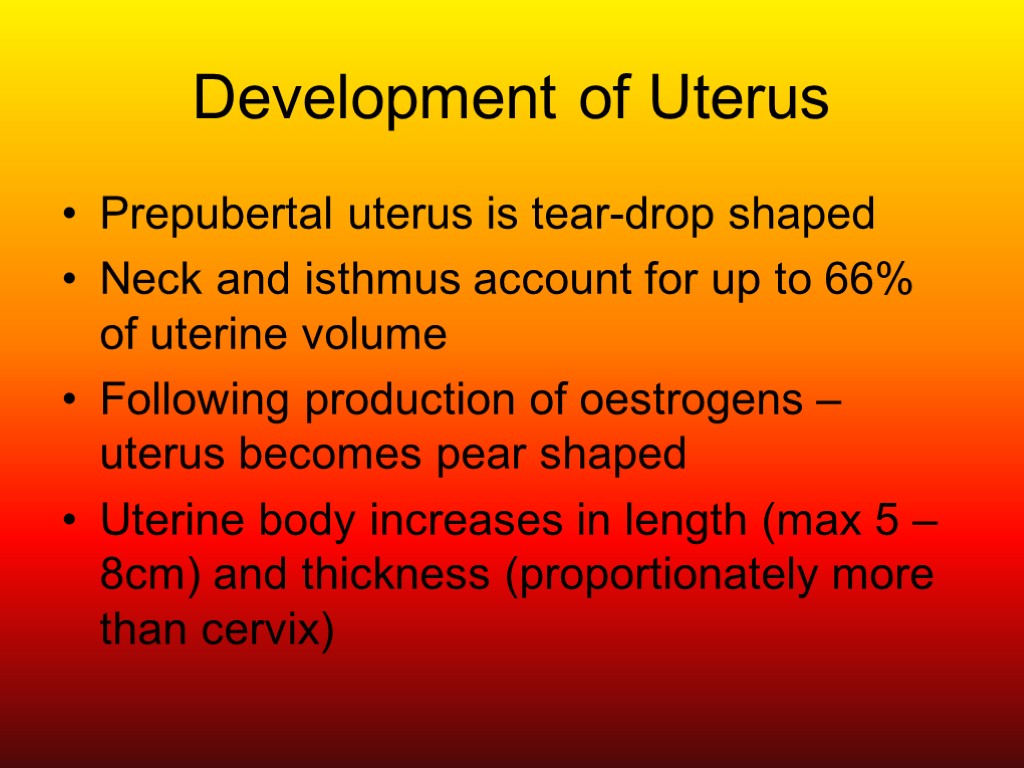
Development of Uterus Prepubertal uterus is tear-drop shaped Neck and isthmus account for up to 66% of uterine volume Following production of oestrogens – uterus becomes pear shaped Uterine body increases in length (max 5 – 8cm) and thickness (proportionately more than cervix)
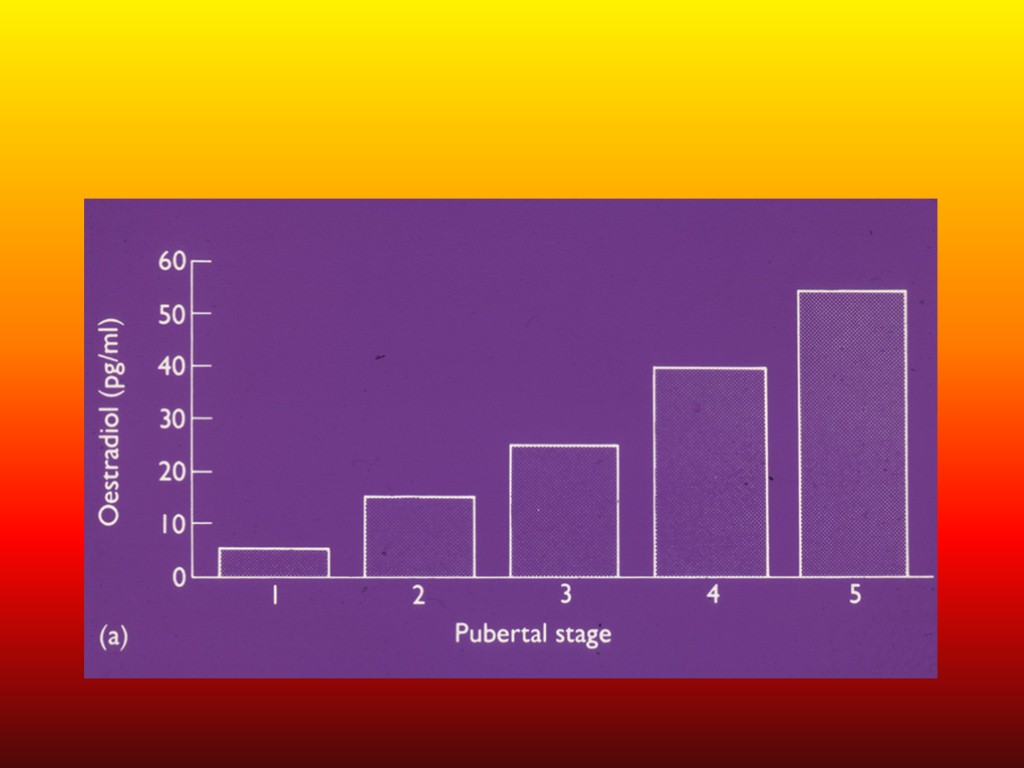

Puberty: Boys First signs often go unnoticed Testicular enlargement (12-13 yrs) Prepubertal testis – 2mls diameter Puberty begins when volume reaches 4mls Penile and scrotal enlargement occur approx 1 yr after testicular enlargement. Pubic hair appears at same time

Pubertal Growth Spurt: Boys Occurs later than in females Testosterone less of a stimulus to GH responsiveness than oestradiol Testosterone required in larger concentrations to produce same anabolic effect Greater and later growth spurt in boys

Examination: Boys Testicular growth: associated with enlargement of seminiferous tubules, epididymis, seminal vesicles and prostate Testicular enlargement: FSH dependant Prader orchidometer: assessment of testicular volume Signs of androgen excess without commensurate increase in testicular volume: worrisome e.g CAH, testicular tumour Penile growth, scrotal changes, pubic hair occur 1-2 yrs after testicular enlargement 50% of males varying degrees of breast hypertrophy Later signs: growth spurt, acne, voice deepening, facial hair

Pubertal Stages (Tanner) Male P1 Prepubertal, testicular volume < 2mls P2 Enlargement of scrotum and penis. Scrotum slightly pigmented. Few long dark pubic hairs P3 Lenghtening of penis. Further growth of testes and scrotum. Pubic hair darker, coarser and more curled P4 Penis increases in length and thickness. Increased pigmentation of scrotum. Adult pubic but no spread to medial thighs P5 Genitalia adult in size and shape. Pubic hair spread to thighs


Secondary sexual development First signs of puberty Testicular volume of 4mls Slight progressive increase in scrotal folds Slight increase in scrotal pigmentation

Testicular Volume


Final height Puberty usually completed within 3 - 4 yrs of onset Left wrist x-ray to assess bone age Final adult height results from complete fusion of epiphyses Occurs approx 2yrs after menarche

Assessment of abnormal puberty Many causes Aim of assessment: determine whether underlying pathological abnormality vs constitutional and benign pubertal changes NB: recognise abnormal timing and progression of puberty

What is abnormal? Delayed Puberty Early or Precocious Puberty More common in females Uncommon in males (usually pathological) < 8yrs in females < 9yrs in males May be associated with a growth spurt

Assessment 1 Full history of previous growth and development Record timing and sequence of physical milestones and behavioural changes of puberty Full medical and surgical history If underweight: take full nutritional history Family hx of early or delayed puberty Family hx of any genetic disease

Assessment 2 Plot height, weight, BMI and growth velocity Compare with old measurements if available Examine all systems: endocrine / neurology NB Optic fundi, visual fields, sense of smell Genitalia, body habitus, stage of puberty

Delayed Puberty: Hypogonadotrophic Constitutional (familial, sporadic) Chronic illness (CF, Crohns Disease, Renal failure) Malnutrition (Anorexia, CF, coeliac disease) Exercise PCOS Tumours of pituitary/hypothalamus (craniopharyngioma) Hypothalamic syndromes (PWS, Laurence-Moon-Biedl) Hypothyroidism Suppression 20 to hyperthyroidism, hyperprolactinemia, Cushing Syndrome, CAH Panhypopituitarism

Delayed Puberty: Hypergonadotrophic Congenital Turner Syndrome Klinefelters Syndrome Acquired Irradiation / Chemotherapy Surgery Testicular torsion, trauma Infection Autoimmunity

Precocious Puberty Onset of secondary sexual characteristics < 8yrs in girls and < 9yrs in boys 5 times more common in girls Usually benign central process – girls Pathological in ~ 50% in boys

Premature thelarche / pubarche Thelarche – beginning of breast development Pubarche – first appearance of pubic hair (more common in certain populations e.g asian / afro-caribbean ) More common than true precocious puberty Benign variants breast development in girls < 3yrs with spontaneous regression Pubic hair in boys and girls < 7yrs due to adrenal androgen secretion in middle childhood NB Examination normal or may be slight advance in growth curve

Precocious Puberty Gonadotrophin dependant Idiopathic (sporadic / familial) Congenital (Hydrocephalus) Acquired (irradiation/surgery/infection) Tumours (hamartomas/gliomas) Hypothyroidism Russell Silver Syndrome Mc Cune Albright Syndrome

Precocious Puberty Gonadotrophin Independant Normal pattern of puberty absent Virilisation of female (CAH) Feminisation of a boy (oestrogen producing leydig tumour) Adrenal Tumour Ovarian Tumour
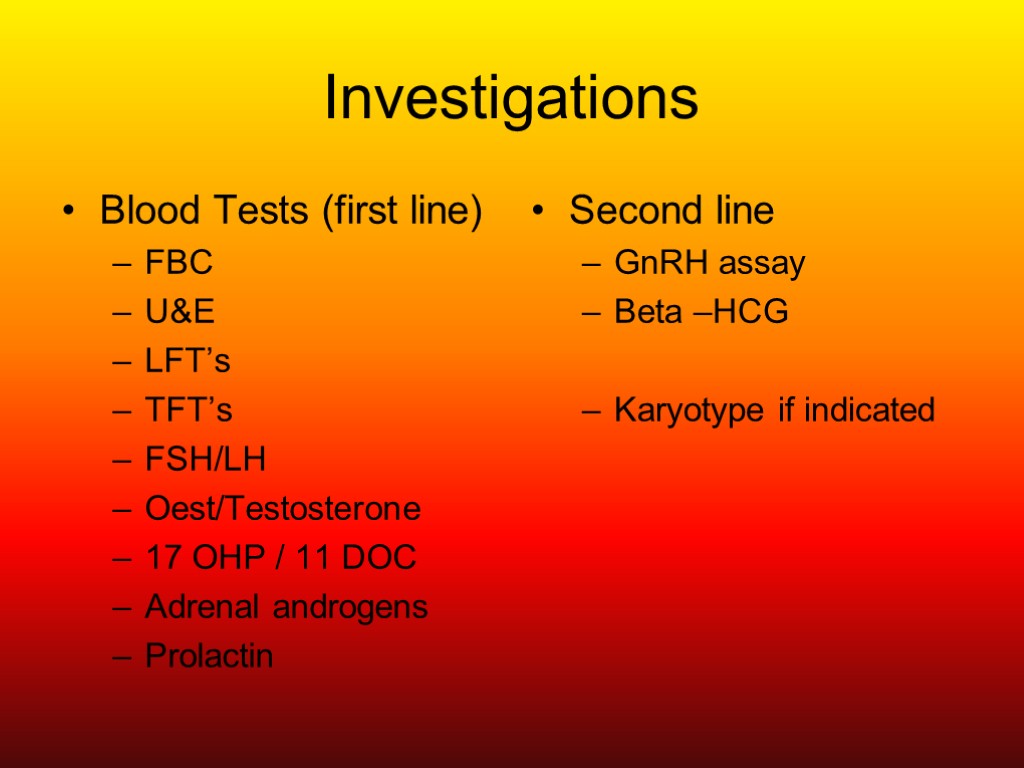
Investigations Blood Tests (first line) FBC U&E LFT’s TFT’s FSH/LH Oest/Testosterone 17 OHP / 11 DOC Adrenal androgens Prolactin Second line GnRH assay Beta –HCG Karyotype if indicated

Diagnostic Imaging Pelvic USS (ovarian tumours / cysts) Testicular USS (tumour) Adrenal USS (MRI / CT better if tumour considered) Bone Age (if within 1yr of CA, puberty not started or only just started; if > 2yrs, puberty already started) Brain MRI in all males and patients with neurological signs or symptoms)

Management Treat systemic disease Psychological support Promote puberty / growth if necessary Low dose testosterone Ethinyloestradiol

Issues Treatment of the cause e.g. cranial neoplasm Behavioural difficulties – psychology Reduce rate of skeletal maturation (early growth spurt may result in early epiphyseal closure and reduced final adult height) Halt or slow puberty (GnRH analogue) Inhibit action of excess sex steroids

Growth and Puberty GH plays role in pubertal development Amplifies ovarian response to gonadotrophins IGF-1 enhances gonadotrophin effect on granulosa cells Isolated GH deficiency associated with pubertal delay, diminished Leydig cell function and decreased response to chorionic gonadotrophins GH administration can restore testicular responsiveness to LH and Leydig Cell steroidogenesis

Growth and Puberty Growth hormone-releasing factor (GRF) levels and GH secretion increase considerably during puberty, mainly at night Amplitude of GH peaks increases in early puberty – growth spurt IGF-1 ►important modulator of growth during childhood and adolescence Adrenal androgens have little physiological role in normal growth
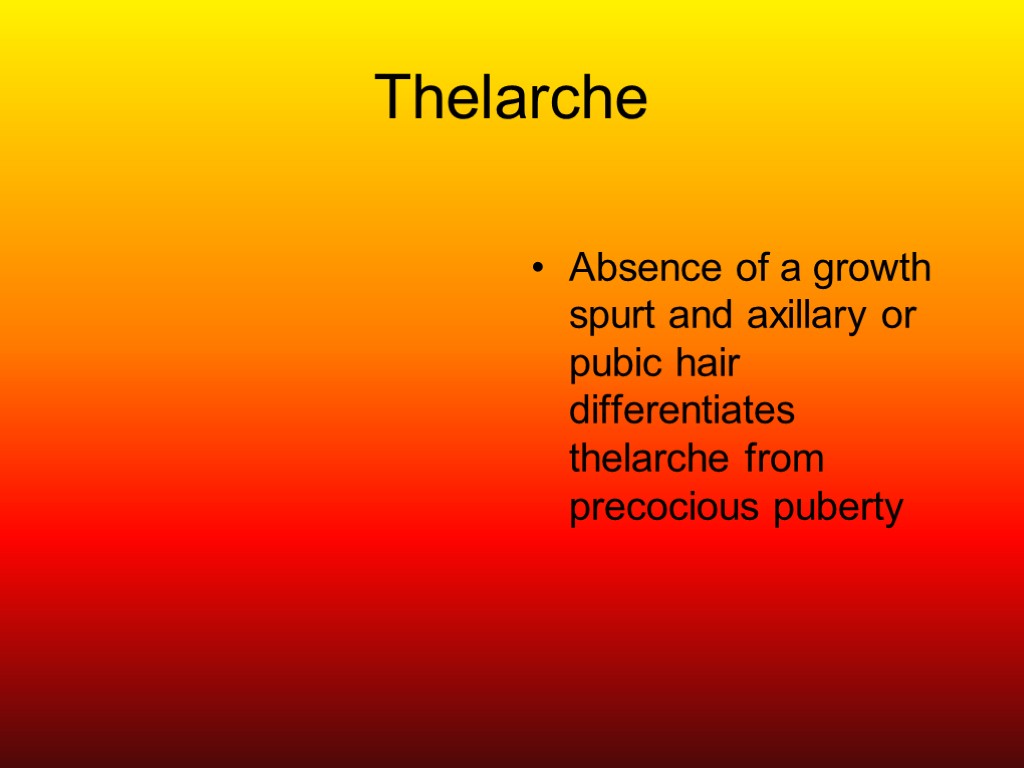
Thelarche Absence of a growth spurt and axillary or pubic hair differentiates thelarche from precocious puberty

Ambiguous genitalia Range of presentations Inadequately developed male to virilised female Most common cause is Congenital Adrenal Hyperplasia → virilised female Urgent identification as can cause adrenal failure in neonatal period Do not ascribe sex immediately Identify cause of intersex Karyotype does not indicate the sex of rearing Family counselling imperative Early surgery now less popular

Thank You
features_of_sexual_development_in_children.ppt
- Количество слайдов: 49

